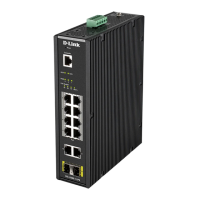
Do you have a question about the D-Link Dis-200G Series and is the answer not in the manual?
Covers accessing Global Configuration mode and creating user accounts.
Displays CLI help system; lists commands, keywords, and arguments.
Enters Global Configuration Mode from Privileged EXEC Mode.
Enables or disables the HTTPS server function on the switch.
Displays information about active lines and logged-in users on the switch.
Creates or deletes user accounts with different privilege levels.
Enables encryption of passwords before storing them in the configuration file.
Configures IPv4 address for an interface or enables DHCP.
Configures static routes, typically for the default gateway.
Displays IP interface information, including IP addresses and status.
Displays the IP routing table, including default gateway information.
Manually configures IPv6 addresses on a management VLAN.
Displays IPv6 interface configuration and status.
Starts cable diagnostics to test copper cable status and length.
Displays current SFP module operating parameters.
Enables and configures DoS prevention mechanisms for specific attack types.
Displays DoS prevention status and related drop counters.
Creates or modifies an ITU-T G.8032 ERP physical ring.
Creates or modifies a G.8032 profile and enters ERP profile configuration mode.
Creates or removes an ERP instance and enters instance configuration mode.
Displays information of ERP instances (status or brief).
Activates or deactivates a specified ERP instance.
Clears dynamic MAC address entries from the MAC address table.
Adds or removes static MAC address entries to the MAC address table.
Displays MAC address table entries by dynamic, static, address, interface, or VLAN.
Enables or disables the IGMP snooping function on the switch.
Enables or disables the IGMP snooping querier capability.
Displays IGMP snooping global state and per-VLAN status.
Displays IGMP snooping group membership information.
Displays IGMP snooping static group information.
Enters interface configuration mode for a specific interface.
Enters interface configuration mode for multiple interfaces.
Displays interface information, including status and statistics.
Displays the switch's port connection status.
Disables an interface, putting it into a disabled state.
Diagnoses basic network connectivity by sending ICMP echo requests.
Assigns an interface to a channel group for link aggregation.
Displays channel group information (summary, detail, neighbor, load-balance).
Enables the Link Layer Discovery Protocol (LLDP) globally.
Displays neighbor information learned from interfaces via LLDP.
Enables the loopback detection function globally.
Enables the loopback detection function for a specific interface.
Displays current loopback detection settings and status.
Configures the destination interface for a port monitor session.
Configures the source port(s) for a port monitor session.
Displays all or specific port mirroring session details.
Enables or disables MLD snooping on VLAN interfaces.
Maps VLANs to MST instances or removes mappings.
Configures the priority for provisioning power to a port.
Configures power management mode for PoE ports.
Enables PD alive check function for PoE ports.
Configures port security settings like aging time, maximum MACs, and violation actions.
Configures the default Class of Service (CoS) value for a port.
Maps Differentiated Services Code Points (DSCP) to Class of Service (CoS).
Configures the port to trust CoS or DSCP fields for QoS operations.
Sets received bandwidth limit values for an interface.
Creates or deletes RADIUS server host entries.
Enables the Safeguard Engine to protect the device from network attacks.
Configures community strings for SNMPv1 and SNMPv2c access.
Configures SNMP groups with security models and views.
Specifies recipients for SNMP notifications (trap hosts).
Creates or removes SNMP users with security models and passwords.
Displays spanning tree protocol operation information.
Enables or disables the STP's global state.
Configures the Spanning Tree Protocol mode (MSTP, RSTP, STP).
Configures the bridge priority for STP/RSTP.
Configures storm control levels for broadcast, multicast, and unicast traffic.
Configures the physical port interface's duplex setting (full, half, auto).
Configures the physical port interface's speed settings (10, 100, 1000, auto).
Copies files within the file system or to/from TFTP servers.
Clears the system's running configuration to default settings.
Resets the system configuration to factory default settings.
Configures a SYSLOG server host for logging system messages.
Displays system messages logged in the local message buffer.
Enables the SSH server function on the switch.
Manually sets the system's clock with specified date and time.
Configures the switch to synchronize its clock with an SNTP time server.
Displays parameters for configured VLANs or specific VLANs.
Specifies the access VLAN for an interface.
Specifies tagged or untagged VLANs for a hybrid port.
Specifies the VLAN mode for a port (access, hybrid, trunk).
Configures allowed VLANs for a trunk interface in tagged format.
Adds or removes VLANs and enters VLAN configuration mode.
Enables the Web authentication function on a port.